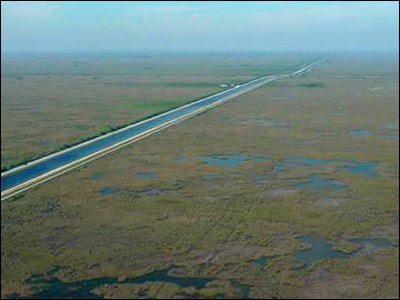Global Sensitivity and Uncertainty Analysis of Hydrologic,
Spatially Distributed Watershed Models
Participants: Zuzanna Zajac, Rafael Muñoz-Carpena, Gregory A. Kiker[596KB], Wendy Graham, Michael Binford (UF), Jayantha Obeysekera (SFWMD), Karl Vanderlinden (IFAPA)
Timeline: August 2006 – August 2010
Funding Agencies: South Florida Water Management District (SFWMD), Water Resources Research Center (WRRC)
Project Summary
Computer model simulations are used widely in the investigation of complex biophysical systems. In particular, hydrological and water quality models are tools that can help to both better understand and manage the water resources.
Currently the typical simulation approach is to treat hydrological models as deterministic. In other words, it is assumed that model outputs are exact and do not incorporate uncertainty. However, it is important to remember that models are just simplifications of the reality and incorporate different sources of uncertainty (i.e. from model input data, parameters, structure, etc.). These uncertainties need to be accounted for in the modeling and in the decision-making process through formal uncertainty analysis. This is particularly critical for all applications informing decisions related to extreme events like drought or flooding.

Global Uncertainty and Sensitivity Analysis (GUA/SA) are formal tools for statistical evaluation of models which contribute to models' quality and application. While the role of the uncertainty analysis is to propagate uncertainties in input factors onto the model outputs of interest, sensitivity analysis studies how the uncertainty in the output can be apportioned to different sources of uncertainty from the model input factors. Local and global types of SA can be distinguished. Local, one-at-a-time (OAT) methods are only effective for the purpose of assessing the relative importance of input factors if the model is linear and additive. In contrast, global techniques enable exploration of the entire interval of definition for each input factor and do not require any assumptions on the model nature.
The uncertainty and sensitivity analysis techniques are applied to the Regional Simulation Model (RSM), the tool that the South Florida Water Management District uses for simulating of water distribution in the natural systems, canals and hydraulic structures for environmental management and drought/flood protection. The study implements geostatistical techniques of sequential simulation for producing alternative, equally probable realizations of spatially distributed numerical and categorical input factors. Furthermore, the method of Sobol is used for GUA/SA. The framework provides quantification of model output uncertainty due to spatially distributed input factors, together with the corresponding sensitivity measures. The methodology allows for the spatial layer to be treated as random variable in the GUA/SA and it accounts for the spatial autocorrelation of variables. The effect of spatial resolution of model input factors, one of the least understood contributors to uncertainty and sensitivity of distributed models, may assessed by this methodology. The framework can be applied to any spatially distributed model and factor and can be used for guiding field measurement campaigns by optimizing data collection in terms of cost-benefit analysis.
Project Impacts
The formal evaluation of spatially distributed hydrological models (like Regional Simulation Model) can contribute to the successful adoption of such tools for water resources management.
Resource Links
- Sensitivity Analysis - European Commission Joint Research Centre
- Regional Simulation Model (RSM) - South Florida Water Management District
Publications
- Muñoz-Carpena, R., Z. Zajac and Yi-Ming Kuo. 2007. Evaluation of Water Quality Models Through Global Sensitivity and Uncertainty Analyses Techniques: Application to the Vegetative Filter Strip Model VFSMOD-W. Trans. of the ASABE 50(5):1719-1732.
- Muñoz-Carpena, R., Z. Zajac, Y.M. Kuo. 2007. Evaluación de modelos de simulación de calidad de aguas mediante técnicas de análisis global de sensibilidad e incertidumbre: aplicación al modelo de filtros vegetales VFSMOD-W. In: J.V. Giráldez Cervera and F.J. Jiménez Hornero (eds.). Estudios de la Zona No Saturada del Suelo Vol. VIII. pp. 53-62. Cordoba (Spain). ISBN: 84-690-7893-8
Presentations & Posters
- Zajac, Z. Application of Global Sensitivity and Uncertainty Analysis Techniques to the Vegetative Filter Strip Model (VFSMOD). Agricultural and Biological Engineers Annual Conference and Trade Show. Saint Petersburg, FL. May 31, 2007.
- Zajac, Z. Global Sensitivity Analysis using the Method of Morris of the South Florida Regional Hydrologic Model - Regional Simulation Model (RSM) - poster. University of Florida Water Institute Symposium. Gainesville, FL. February 28, 2008.
- Zajac, Z. Global Sensitivity Analysis using the Method of Morris of the South Florida Regional Hydrologic Model - Regional Simulation Model (RSM) - poster. American Geophysical Union (AGU) Joint Assembly, Fort Lauderdale, FL. May 28, 2008.
- Zajac, Z. Global Sensitivity Analysis using the Method of Morris of the South Florida Regional Hydrologic Model-Regional Simulation Model (RSM). Florida Section Agricultural and Biological Engineers Annual Conference and Trade Show. Duck Key, FL. June 13, 2008.
- Zajac, Z. Uncertainty Analysis of Spatially Distributed Hydrological Model, Regional Simulation Model (RSM), as a Tool for Optimization of Spatial Data Collection. Florida Section Agricultural and Biological Engineers Annual Conference and Trade Show. Daytona Beach, FL. June 12, 2009.
- Zajac, Z. Global Uncertainty and Sensitivity Analysis of Spatially Distributed Hydrological Model, Regional Simulation Model (RSM), to spatially distributed factors. AGU Fall Meeting. San Francisco, CA. December 17, 2009.
This page was last updated on July 13, 2019.